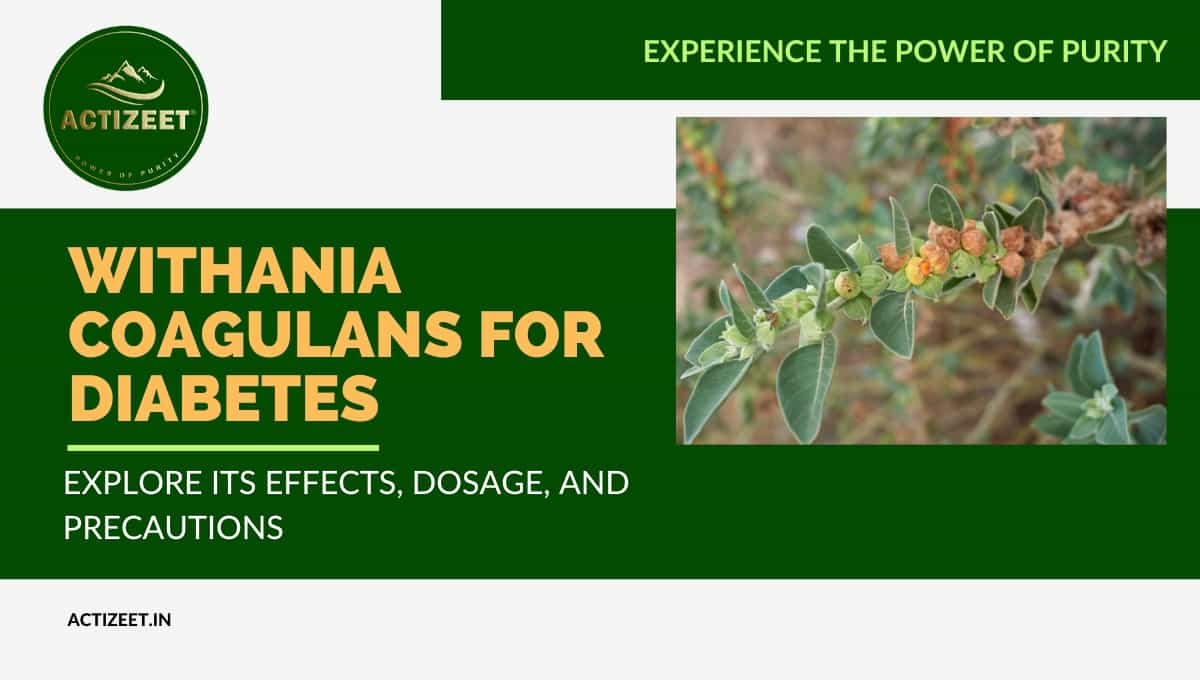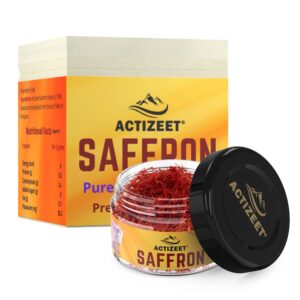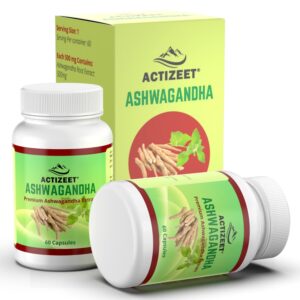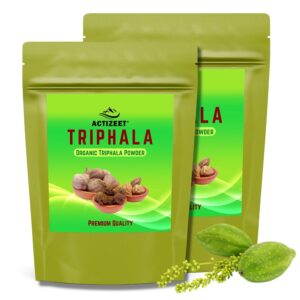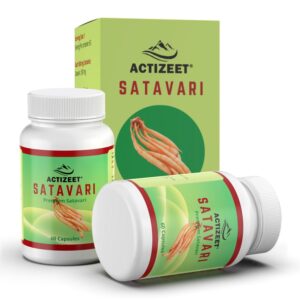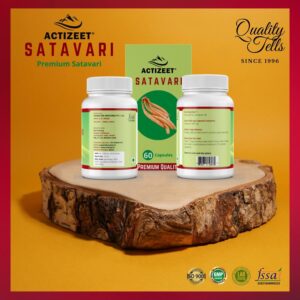Withania Coagulans, commonly known as Indian Rennet or Paneer Dodi, is a fascinating plant that has garnered attention for its potential benefits in managing various health conditions, including diabetes. Native to India and neighboring regions, this plant belongs to the Solanaceae family and is characterized by its small yellow flowers and spherical fruits covered in thorny calyxes. While the plant itself may seem unassuming, it possesses remarkable properties that have been utilized in traditional medicine for centuries.
Table of Contents
ToggleOverview of Withania Coagulans Plant
Withania coagulans is a perennial shrub that typically grows up to 1-2 meters tall. Its leaves are simple, oval-shaped, and covered with tiny hairs. The plant thrives in dry climates and can be found in sandy or gravelly soils.
Interestingly, what sets Withania Coagulans apart is the presence of a sticky resinous substance on the outer surface of its fruits. The fruits of Withania coagulans have long been used by locals in various traditional practices.
They possess coagulating properties, making them ideal for curdling milk during cheese-making processes. This unique property has led to their colloquial name “Indian Rennet.” Additionally, extracts from different parts of the plant have been employed as a natural remedy for several ailments due to their potential health benefits.
History and Traditional Uses of Withania Coagulans
The historical use of Withania Coagulans dates back centuries when Ayurvedic practitioners recognized its medicinal value. In Ayurveda – India’s ancient holistic healing system – it holds a special place due to its rejuvenating and adaptogenic properties.
Ancient texts and folklore describe the traditional uses of Withania Coagulans for various purposes. It has been employed as a digestive aid and an aphrodisiac.
Moreover, it has been used to improve overall vitality, enhance immune function, and support reproductive health. In addition to these benefits, Withania coagulans has long been associated with its potential to assist in managing diabetes.
The rich history and traditional use of Withania Coagulans have paved the way for scientific investigations into its properties. Let us delve deeper into how this remarkable plant may hold promise in the realm of diabetes management.
Understanding Diabetes
Definition and types of diabetes
Diabetes, a chronic metabolic disorder, is characterized by elevated levels of sugar (glucose) in the blood. It occurs due to the body’s inability to produce or effectively use insulin, a hormone responsible for regulating blood sugar levels.
There are primarily three types of diabetes: Type 1 diabetes, Type 2 diabetes, and gestational diabetes. Type 1 diabetes typically develops during childhood or adolescence and is caused by an autoimmune response that destroys the insulin-producing cells in the pancreas.
Individuals with Type 1 diabetes rely on regular insulin injections to manage their blood sugar levels. Type 2 diabetes is the most common form of the condition, usually occurring in adulthood.
It arises when the body becomes resistant to insulin or fails to produce enough insulin to meet its needs. Lifestyle factors such as poor diet, sedentary behavior, obesity, and genetic predisposition contribute significantly to Type 2 diabetes development.
Gestational diabetes affects pregnant women who do not have pre-existing diabetes but develop high blood sugar levels during pregnancy. Although it usually resolves after giving birth, it increases the risk of developing Type 2 diabetes later in life.
Causes and risk factors associated with diabetes
The causes of different types of diabetes vary: – For Type 1 diabetes, genetic susceptibility combined with environmental triggers like viral infections may lead to its onset.
– In contrast, an unhealthy lifestyle plays a significant role in the development of Type 2 diabetes. Factors such as excessive consumption of sugary foods and drinks, lack of physical activity, and overweight or obesity contribute to insulin resistance and impaired glucose metabolism.
– Gestational diabetes is primarily influenced by hormonal changes during pregnancy that affect how cells respond to insulin. Apart from these causes specific to each type, there are common risk factors associated with all forms of diabetes.
These include a family history of diabetes, age (being over 45), ethnicity (such as African, Asian, or Hispanic descent), high blood pressure, and polycystic ovary syndrome (PCOS). Furthermore, individuals with a history of gestational diabetes or prediabetes are at higher risk of developing Type 2 diabetes later in life.
Understanding the definition, types, causes, and risk factors of diabetes helps create awareness about this prevalent condition. It is essential to emphasize the importance of proactive measures to prevent and manage diabetes effectively.
Role of Withania Coagulans in Diabetes Management
Active compounds present in Withania Coagulans
Withania coagulans, also known as “Indian rennet” or “Paneer Dodi,” is a plant endemic to India and Pakistan. It possesses a range of bioactive compounds that have been studied for their potential benefits in managing diabetes. One such compound is Withanolide A, which has been shown to exhibit anti-diabetic properties by reducing blood glucose levels.
This compound works by enhancing insulin secretion from the pancreatic beta cells, thus promoting better utilization of glucose by the body’s cells. Additionally, Withania Coagulans contains flavonoids like Quercetin and Rutin that possess antioxidant properties, which can help control oxidative stress associated with diabetes.
Mechanisms by which Withania Coagulans may help regulate blood sugar levels
Several mechanisms have been proposed to explain how Withania Coagulans aids in regulating blood sugar levels. Firstly, it has been suggested that this plant promotes pancreatic beta cell regeneration and enhances their function. By increasing insulin secretion, it facilitates the transport of glucose across cell membranes, leading to improved glycemic control.
Furthermore, Withania Coagulans may also exert its effects through its anti-inflammatory properties. Chronic inflammation plays a significant role in the development and progression of diabetes.
By reducing inflammation in adipose tissue and improving insulin sensitivity at the cellular level, this medicinal plant may contribute to better glycemic control. Moreover, some studies have indicated that Withanolide A inhibits alpha-glucosidase activity—an enzyme responsible for breaking down complex carbohydrates into simple sugars—thus slowing down carbohydrate absorption from the digestive system.
This mechanism can prevent sudden spikes in blood sugar after meals. Withania coagulans demonstrates promising potential in the management of diabetes.
Its active compounds, such as Withanolide A and flavonoids, contribute to regulating blood sugar levels through various mechanisms, including enhanced insulin secretion, anti-inflammatory effects, and inhibition of carbohydrate absorption. However, further research is needed to fully understand the extent of its efficacy and determine optimal dosage recommendations.
Scientific Evidence on the Efficacy of Withania Coagulans for Diabetes
Reviewing clinical studies on the effects of Withania Coagulans on blood glucose control
When it comes to managing diabetes, scientific evidence plays a crucial role in determining the effectiveness of alternative therapies. Several clinical studies have investigated the impact of Withania Coagulans on blood glucose control, shedding light on its potential as a supportive treatment option for individuals with diabetes.
Study 1: Impact on fasting blood sugar levels
In a notable study conducted by researchers, participants with type 2 diabetes were given a daily dosage of Withania Coagulans extract over twelve weeks. The results revealed a significant reduction in fasting blood sugar levels among those who consumed the extract compared to the control group. This finding suggests that Withania Coagulans may possess hypoglycemic properties that can help regulate glucose metabolism and improve glycemic control.
Furthermore, additional analyses demonstrated that participants who took Withania Coagulans experienced reduced postprandial glucose levels after consuming meals. This further supports the potential benefits of this herb in preventing sudden spikes in blood sugar levels, which are often problematic for people managing diabetes.
Study 2: Effectiveness in reducing HbA1c levels
Another compelling study explored the effectiveness of Withania Coagulans in reducing HbA1c levels—a key marker used to evaluate long-term glycemic control. The research involved individuals with type 2 diabetes who received either a daily supplement containing Withania Coagulans or a placebo for three months.
The results demonstrated that those who consumed Withania Coagulans experienced a significant decrease in their HbA1c levels compared to the placebo group. This finding suggests that regular use of this herb may contribute to improved long-term blood sugar management, thereby reducing the risk of diabetes-related complications.
While these studies provide promising insights into the potential benefits of Withania Coagulans for diabetes management, it is important to note that further research is still needed to fully understand its mechanism of action and determine appropriate dosage guidelines. As always, it is advisable to consult with a healthcare professional before incorporating any new supplements into your diabetes treatment plan.
Potential Benefits Beyond Blood Sugar Control
Antioxidant properties of Withania coagulans and its role in preventing diabetic complications
When it comes to managing diabetes, it’s not just about controlling blood sugar levels. Diabetic individuals often face a higher risk of developing complications due to oxidative stress, which damages cells and tissues. This is where the antioxidant properties of Withania Coagulans come into play.
Withania coagulans contains bioactive compounds like flavonoids, alkaloids, and phenolic acids that possess potent antioxidant effects. These antioxidants can neutralize harmful free radicals in the body, reducing oxidative stress and protecting against long-term damage.
By safeguarding cells from oxidative damage, Withania Coagulans may help prevent or alleviate various diabetic complications such as neuropathy (nerve damage), retinopathy (eye damage), nephropathy (kidney damage), and cardiovascular diseases. The powerful antioxidant activity of Withania Coagulans makes it an exciting natural remedy for individuals with diabetes who wish to protect their overall health.
Impact on insulin resistance and lipid profile improvement
Insulin resistance is a common issue among individuals with type 2 diabetes. It occurs when the body’s cells become less responsive to insulin, leading to elevated blood sugar levels. Research suggests that Withania Coagulans may have a positive impact on insulin sensitivity, potentially improving glycemic control in those with type 2 diabetes.
Furthermore, studies have shown that this remarkable herb may also contribute to improving lipid profiles in individuals with diabetes. High cholesterol and triglyceride levels are often associated with diabetes and pose a significant risk for heart disease.
However, Withania Coagulans has been found to help lower total cholesterol levels while increasing the levels of “good” HDL cholesterol. The lipid-lowering effects of Withania Coagulans can help reduce the risk of atherosclerosis (plaque buildup in arteries) and protect against cardiovascular complications associated with diabetes.
By positively influencing both insulin resistance and lipid profiles, Withania Coagulans holds great promise as a natural remedy for managing not only blood sugar levels but also preventing secondary health issues in those living with diabetes. Overall, the potential benefits of Withania Coagulans extend beyond its effects on blood sugar control.
Its antioxidant properties may help prevent diabetic complications by combating oxidative stress, while its impact on insulin resistance and lipid profile improvement can contribute to better overall health management for individuals with diabetes. Incorporating Withania Coagulans into a holistic approach to diabetes care may offer numerous advantages, but always remember to consult your healthcare provider before making any significant changes to your regimen.
Forms and Dosage Recommendations for Using Withania Coagulans
Types available (powder, capsules, extracts)
When it comes to using Withania Coagulans for diabetes management, there are several different forms available on the market. One popular option is the powdered form of Withania coagulans.
This versatile form can be easily mixed into smoothies, juices, or even sprinkled onto your favorite dishes. It offers a convenient way to incorporate this beneficial herb into your daily routine.
Another common option is capsules or tablets containing Withania Coagulans extract. These capsules provide a precise dosage of Withania coagulans and are an excellent choice if you prefer a more standardized approach.
They are convenient to take and can be easily included in your daily supplement regimen. You may come across liquid extracts of Withania coagulans.
These extracts are highly concentrated forms of the herb and often require dilution before use. They offer a potent option for those seeking maximum benefits from this plant.
Guidelines for safe dosage based on scientific research
Determining the appropriate dosage of any herbal supplement requires careful consideration of various factors such as age, health condition, and individual tolerance. While there is no universal dosage recommendation for using Withania Coagulans specifically for diabetes management, scientific research provides some general guidelines. For powdered or capsule forms of Withania coagulans, most studies suggest a daily dose ranging from 500 mg to 2 grams per day divided into two or three doses.
It is important to start with a lower dose and gradually increase it while monitoring its effects on blood sugar levels. In the case of liquid extracts, due to their higher concentration levels, it is recommended to follow the instructions provided by the manufacturer or consult with a healthcare professional who can guide you in determining an appropriate dosage based on your individual needs.
Remember, it is crucial to seek guidance from a healthcare provider before incorporating Withania Coagulans into your diabetic lifestyle. They can evaluate your specific situation and provide personalized advice on the ideal dosage for you.
Side Effects and Precautions
Common side effects associated with the use of Withania Coagulans
When it comes to using Withania Coagulans for diabetes management, it is important to be aware of any potential side effects. Although generally regarded as safe, some individuals may experience mild adverse reactions. These commonly reported side effects include gastrointestinal discomfort such as nausea, bloating, or an upset stomach.
It’s crucial to note that these symptoms are usually temporary and tend to subside on their own. Moreover, some users have reported allergic reactions like itching or skin rashes after consuming Withania coagulans.
If you notice any unusual symptoms after taking this herb, it is essential to discontinue its use and seek medical advice promptly. Additionally, pregnant or breastfeeding women should consult their healthcare professional before incorporating Withania Coagulans into their routine.
Potential drug interactions or contraindications to be aware of
While Withania Coagulans is generally considered safe for most people, it is always wise to exercise caution when combining herbal supplements with prescription medications. Certain medications may interact with the active compounds present in Withania Coagulans, potentially altering their effectiveness or causing unwanted side effects.
If you are taking immunosuppressant drugs or medications that affect blood sugar levels such as insulin or oral hypoglycemic agents for diabetes control, it is advisable to consult your healthcare provider before adding Withania Coagulans to your regimen. Additionally, individuals on sedatives or anti-anxiety medications should exercise caution because Withania Coagulans may enhance the sedative properties of these drugs.
Remember that communication with your healthcare professional is crucial in ensuring your safety and well-being while using natural remedies like Withania coagulans. They can provide personalized guidance based on your specific health condition and the medications you are currently taking.
Tips for Incorporating Withania Coagulans into a Diabetic Lifestyle
Before integrating Withania Coagulans into your diabetes management routine, it is crucial to consult with your healthcare provider. Every individual’s health needs are unique, and your doctor can provide personalized guidance based on your specific condition, current medications, and overall health profile. They will assess whether incorporating Withania Coagulans is appropriate for you and determine the ideal dosage that suits your requirements.
Additionally, your healthcare provider can monitor your progress and make necessary adjustments to optimize the benefits of using Withania coagulans. Engaging in open communication with them ensures that you are taking the necessary precautions while embarking on this natural supplementation journey.
Conclusion
Incorporating Withania Coagulans into a diabetic lifestyle holds immense potential in helping manage blood sugar levels and reducing the risk of complications associated with diabetes. However, it is crucial to remember that no single supplement can replace a well-rounded approach to diabetes management.
A healthy lifestyle comprising regular exercise, a balanced diet, stress reduction techniques, medication compliance (if prescribed), and regular monitoring of blood sugar levels remain fundamental pillars in managing diabetes effectively. By working closely with healthcare professionals and making informed choices about natural supplements like Withania Coagulans, individuals living with diabetes can take proactive steps towards achieving better control over their condition.
Embracing these holistic strategies fosters optimism and empowers individuals to lead fulfilling lives despite the challenges posed by diabetes. Remember: managing diabetes may require effort, but it also opens doors to healthier habits and increased well-being.
Related Products
-
Himalayan Shilajit, Pure shilajit, Shilajit, SHUDDH SURYA TAPI SHILAJIT
Rated 4.74 out of 5₹4,950.00Original price was: ₹4,950.00.₹3,950.00Current price is: ₹3,950.00. Incl. GST ADD TO CART Buy Now -
Rated 4.86 out of 5
₹2,400.00Original price was: ₹2,400.00.₹1,600.00Current price is: ₹1,600.00. Incl. GST ADD TO CART Buy Now -
Rated 4.82 out of 5
₹2,400.00Original price was: ₹2,400.00.₹1,600.00Current price is: ₹1,600.00. Incl. GST ADD TO CART Buy Now -
Rated 4.84 out of 5
₹2,400.00Original price was: ₹2,400.00.₹1,600.00Current price is: ₹1,600.00. Incl. GST ADD TO CART Buy Now
-
Rated 4.00 out of 5
₹2,400.00Original price was: ₹2,400.00.₹1,600.00Current price is: ₹1,600.00. Incl. GST ADD TO CART Buy Now -
Rated 4.80 out of 5
₹2,400.00Original price was: ₹2,400.00.₹1,600.00Current price is: ₹1,600.00. Incl. GST ADD TO CART Buy Now -
Rated 4.71 out of 5
₹2,400.00Original price was: ₹2,400.00.₹1,600.00Current price is: ₹1,600.00. Incl. GST ADD TO CART Buy Now -
Rated 0 out of 5
₹2,400.00Original price was: ₹2,400.00.₹1,600.00Current price is: ₹1,600.00. Incl. GST ADD TO CART Buy Now
POPULAR PRODUCT CATEGORIES
Related posts:
- Harnessing the Power of Amla Powder for Diabetes Management: A Natural Approach
- Safed Musli: A Natural Supplement For Diabetes Management
- Unlocking the Potential: Essential Oils for Diabetes Relief
- Syzgium Cumini For Diabetes – Natural Way To Combat Diabetes
- Moringa Powder: A Natural Remedy for Diabetes?
- Unlocking the Wellness Potential of Amla Powder: Exploring Its Benefits for Health
- Emblica Officinalis: A Natural Remedy for Diabetes
- Terminalia Bellirica for diabetes – A Primordial Medicinal Herb

